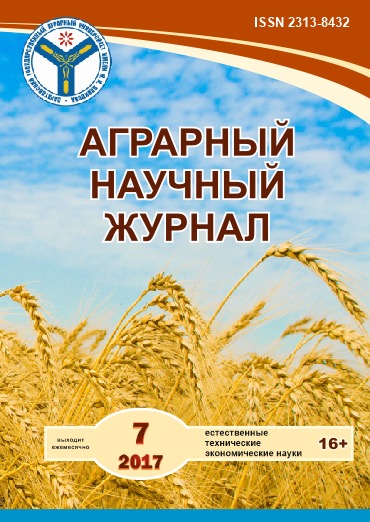MOLECULAR GENETIC IDENTIFICATION AND TYPING RUSSIAN ISOLATES OF ANA-PLASMA MARGINALE
Keywords:
Anaplasma marginale, msp4, bovine anaplasmosis, PCR, genotyping, sequencingAbstract
Anaplasma marginale (order Riсkettsiales, family Anaplasmatacеa) is an intraerithrocytic parasite and a causative agent of bovine anaplasmosis. Bovine anaplasmosis causes significant economic losses to animal husbandry. This article presents the results on identification and mo-lecular genetic typing of Russian isolates of A. marginale. Detection of infected animals was per-formed by TaqMan real-time polymerase chain reaction assay. It was shown that 41,9 % of tested animals were infected with A. marginale. Genotyping the obtained A. marginale isolates was car-ried out on the basis of msp4 genesequencing data. The analysis of the obtained sequences elicited that Russian isolates of A. marginale belong to two known genotypes.
Downloads
References
2. Георгиу Х., Белименко В.В. Анаплазмоз крупного рогатого скота // РВЖ. Сельскохозяйственные животные. – 2015. ? № 1. – С. 5?7.
3. Казаков Н.А. Минимальная заражающая доза возбудителей (A. marginale, A. ovis) при анаплазмозе КРС и овец – критерий объективной оценки иммуногенных свойств противоанаплазмозных адьювантных инактивированных эмульгированных вакцин // Ветеринарная патология. – 2008. ? № 2. – С. 68–70.
4. Казаков Н.А., Идина М.Ф. Анаплазмоз крупного рогатого скота в Тверской области // Ветпатология. – 2009. – № 2. – С. 72–75.
5. Кровепаразитарные болезни домашних животных (Атлас) / М.И. Гулюкин [и др.]. – М.: ЗооВетКнига, Динамика накопления амплифицированных фрагментов гена msp4 A. marginale в ходе ПЦР в режиме реального времени. Ось ординат ? уровень флуоресценции, ось абсцисс ? количество циклов ПЦР. К?? отрицательный контроль 2013. – С. 86.
6. Либерман Е.Л., Хлызова Т.А. Зависимость инвазирования крупного рогатого скота анаплазмозом от численности насекомых комплекса «Гнус» // Educatio. ? 2015. ? № 3. ? С. 46–50.
7. Распространение клещей Ixodes ricinus L., 1758 и Ixodes persulcatus Shulze, 1930 (Parasitiformes, Ixodidae) на территории России и соседних стран и наблюдаемые изменения климата / Е.В. Казакова [и др.] // Доклады Академии наук. – 2009. – № 5. – С. 688–692.
8. Разработка метода выявления Anaplasma marginale с использованием ПЦР в реальном времени / С.Н. Ковальчук [и др.] // Сельскохозяйственная биология. – 2015. – № 6. – С. 825–831.
9. Dark M.J., Herndon D.R., Kappmeyer L.S., Gonzales M.P., Nordeen E., Palmer G.H. Conservation in the face of diversity: multistrain analysis of an intracellular bacterium // BMC Genomics, 2009, Vol. 10, P. 16.
10. Fuente J., Rubial P., Mtshali M. S., Naranjo V., Shuqing L., Mangold A.J. Analysis of world strains of Anaplasma marginale using major surface protein 1a repeat sequence / // Vet Microbiol., 2006, Vol. 119, P. 382–390.
11. Fuente J., Van Den Bussche R.A., Kocan K.M. Molecular phylogeny and biogeography of North American isolates of Anaplasma marginale (Rickettsiaceae: Ehrlichieae) // Veterinary parasitology, 2001, Vol. 97, P. 65–76.
12. Guglielmone A.A. Epidemiology of babesiosis and anaplasmosis in South and Central America // Veterinary parasitology, 1995, Vol. 57, P. 109–119.
13. Hornok S., Foldvari G., Elek V., Naranjo V., Farkas R., Fuente J. Molecular identification of Anaplasma marginale and rickettsial endosymbionts in blood-sucking flies (Diptera: Tabanidae, Muscidae) and hard ticks (Acari: Ixodidae) // Veterinary parasitology, 2008, Vol. 154, P. 354?359.
14. Kivaria F.M. Estimated direct economic costs associated with tick-borne diseases on cattle in Tanzania // Tropical Animal Health and Production, 2006, Vol. 38, P. 291?299.
15. Kocan K.M., de la Fuente J., Blouin E.F., Coetzee J.F., Ewing S.A. The natural history of Anaplasma marginale // Veterinary parasitology, 2010, Vol. 167, P. 95?107.
16. McCallon В.R. Preva1ence and economic aspects оf anap1asmosis. In: Proceedings оf the 6-th Nationa1 Anaplasmosis Conference, Las Vegas, Nevada, 1973, P. 1?3.
17. Ogata H., Audic S., Renesto-Audiffren P., Fournier P.E., Barbe V., Samson D., Roux V., Cossart P., Weissenbach J., Claverie J.M., Raoult D. Mechanisms of evolution in Rickettsia conorii and R. prowazekii // Science, 2001, V. 293, P. 2093?2098.
18. Strik N.I., Alleman A.R., Barbet A.F., Sorenson H.L., Wamsley H.L., Gaschen F.P., Luckschander N., Wong S., Chu F., Foley J.E., Bjoersdorff A., Stuen S., Knowles D.P. Characterization of Anaplasma phagocytophilum major surface protein 5 and the extent of its cross-reactivity with A. marginale // Clinical and vaccine immunology, 2007, V. 14, P. 262?268.
19.Waal D.T. Anaplasmosis control and diagnosis in South Africa // Annals of the New York Academy of Sciences, 2000, No. 916, P. 474?483.








